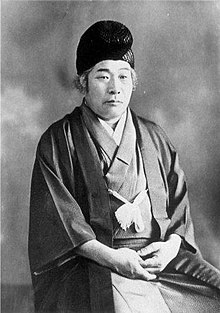|
Onisaburo Deguchi
Onisaburo Deguchi (出口 王仁三郎, Deguchi Onisaburō), born Kisaburō Ueda 上田 喜三郎 (1871–1948) was a Japanese religious leader. Together with his mother-in-law Nao Deguchi, he was one of the two spiritual leaders of the Oomoto religious movement in Japan. BiographyOnisaburo had studied Honda Chikaatsu's Spirit Studies (Honda Reigaku), he also learned to mediate spirit possession (chinkon kishin) from Honda's disciple Nagasawa Katsutate in Shizuoka. Starting from March 1, 1898, he followed a hermit called Matsuoka Fuyō (松岡芙蓉), who was a messenger of the kami Kono-hana-saku-ya-hime-no-mikoto (木花咲耶姫命), to a cave on Mount Takakuma near Kameoka, Kyoto, where Onisaburo performed intense ascetic training for one week. While enduring cold weather with only a cotton robe, as well as hunger and thirst, Onisaburo received divine revelations and claimed to have traveled into the spirit world.[1][2] Onisaburo met the founder of Omotokyo in 1898 and in 1899 they established the Kinmeikai, later called Kinmei Reigakkai. In 1900 Kisaburō married Nao's fifth daughter Sumi and adopted the name Deguchi Onisaburō. Oomoto teaches that the guardian spirit of Nao is Amaterasu, described as a male spirit in a female body, and Onisaburo's spirit is Susanowo, a female spirit in a male body.[3] In 1908 he and Deguchi Nao founded the Dai Nihon Shūseikai (大日本修斎会), which in 1913 became Taihonkyō (大本教) and in 1916 the Kōdō Ōmoto (皇道大本). Soon afterwards, he began publishing a periodical journal called Shinreikai (神霊界; "World of Gods and Spirits").[4] In 1923, he learned Esperanto, an international planned language, and introduced it to the activities of Oomoto. In 1924, retired naval captain Yutaro Yano and his associates within the Black Dragon Society invited Onisaburo on a journey to Mongolia. Onisaburo led a group of Oomoto disciples, including Aikido founder Morihei Ueshiba. Ikki Kita had previously been sent to China by the Black Dragon Society and had proposed in for Esperanto to be the only language spoken in the Empire of Japan. In 1925, he wrote Michi no shiori (道の栞) (lit. 'Guide to the Way').[4] In Ōmoto Incident, he had been detained for about six years and a half since his arrest in 1935. He is remembered as a jovial patriarch of that school and is best known to Westerners as a teacher and religious instructor of Morihei Ueshiba, the founder of aikido. A believer in the Oomoto maxim that it was humanity's duty to move forward together, bringing about a new age of existence on Earth, Onisaburo went to great lengths to promote the syncretic faith preached by Nao Deguchi. He wrote the Reikai Monogatari (Tales of the Spirit World), an 81-volume work that covered his alleged travels into the spiritual planes of existence, as well as many other theologically permeated stories which expounded on numerous Oomoto spiritual ideals. Onisaburo Deguchi also wrote numerous other texts, such as Michi no Oomoto (道の大本) and Tama no Ishizue (霊の礎). Throughout his life, Onisaburo was often quite flamboyant, taking delight in wearing richly textured costumes of his own design and posing as a wide variety of deities, mostly Buddhist or Shinto. He would also dress like a shaman, and often even took up the appearances of female divinities. His outlook on life tended to be eclectic, sometimes even to the point of being outrageous. At varying points of his lifetime, he claimed to be an incarnation of Miroku Butsu (Sanskrit: Maitreya Buddha), and often referred to himself as a remodeler of the world. Like most Oomoto followers, Onisaburo believed that the original kami founders of Japan, were driven away by the kami of the imperial line. This placed him in opposition to the authorities at the time, though he had the ability to hide it. This again differentiated him from Nao Deguchi, who was more open and direct in her proclamations. Onisaburo was quite talented in quieting the government officials while at the same time subverting their efforts that he found distasteful or amoral. Onisaburo's legacy is largely concerned with art, including a wealth of calligraphic and poetic works. He also dabbled in cinema, sculpture, and pottery, leaving behind thousands of items that are now considered by many enthusiasts to be of great value. Onisaburo is known for the coining the proverb "Art is the mother of religion" (芸術は宗教の母, geijutsu wa shūkyō no haha).[4] Sacred sitesSome Oomoto sacred sites associated with Onisaburo Deguchi include:
References
Further reading
External linksWikimedia Commons has media related to Deguchi Onisaburo.
Information related to Onisaburo Deguchi |
||||||||||||||||||||

